Daduji: Abdullah Malik
By Omar Kauser Malik
Friday times 18 Jul 2014
Omar Kauser Malik remembers his grandfather, the socialist writer Abdulla Malik (1920-2003), whose informative memoir of Lahore inspires a love of pluralism

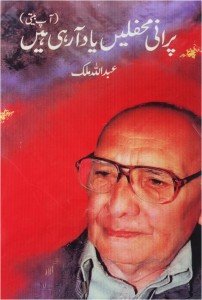
‘Omar ji koye gup shup sunaoo,’ are the words I heard and, as I looked up, there he was in his off-white boski ka kurta and old traditional white pajama, gazing at me with a twinkle in his eyes. He sat down in front of me, as he always did, and we chatted about everything that we always chatted about and suddenly I felt my son Muhammad kissing me and I got up from my encounter with ‘Dadabu’.
The entire day I sat in the veranda of my house on the border of Model Town in Lahore and tried to doze off into the same dream. I live in my ancestral house, which is home not only to me but also to memories of a ‘Pakka Lahori’. This institution was my Dadabu, or Dada-Abu (Grandfather), the late Abdulla Malik (or ‘Malik Sahib’, as he was known), a mentor, supporter and well-wisher of many of Pakistan’s eminent journalists, poets, literary and political personalities. He started from humble beginnings; he was the last of the comrades; and although he lived long enough to see the demise of the Soviet Union and the dismantling of communism, to his dying day he did not waver in his faith in socialism and in its power to provide justice to the deprived and the disinherited.
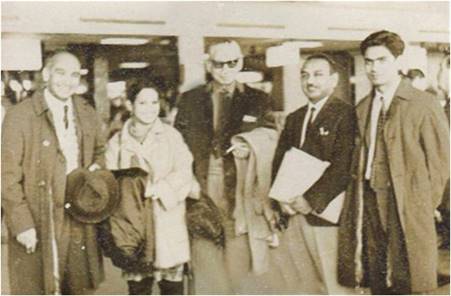
Abdulla Malik with communist leader Sajjad Zaheer and others
He did not waver in his faith in socialism
Dadabu had the ingredients of a true Lahori. A journalist and political historian, he didn’t take an active part in politics but, as his friend the late Hamid Akhter Sahib (died October 16,2011) used to say about him: “Abdullah is the one who brings warriors to his Gol Kamra [drawing room], cleans them, briefs them on political war strategies and tactics and sends them off to the battle field.”
Dadabu used to say, “Hamari sab se shanasai hai,” (‘I am in touch with everyone,”) and true it was. His friends included the poet Faiz Ahmad Faiz, the historian Syed Sibt-e-Hassan, the lawyer Ijaz Bitalwi and the writer and activist Hamid Akhter. He was also friends with Altaf Gohar, I.A. Rehman, Kishwar Naheed and Tahira Mazhar Ali Khan. He had the capacity to befriend the very young, the young and the not-so-young alike.
It is said that there is a special relationship between a grandson and his grandfather. My relationship with him fits the saying. I spent my college life in Lahore with him while my parents were posted in Faisalabad. Dadabu was a friend, supporter, motivator, critic and now, when I look back, I realize that he was my link to the most inspirational people I know of today. He always said, “Omar ji, waqt insan ko sab sikha deta hai,” (‘Time teaches one everything’), adding that I would see the good and the bad of the world with time.

With long time close friend Khalid Hassan
“Some of the people Faiz chose as his friends caused him much unhappiness”
Abdullah Malik was a Kakkaizai Pathan. He was not averse to a fight, and he would go to any length to defend his friends. One such friend and someone he respected a lot was Faiz Ahmad Faiz (d. 1984). I always knew about his strong emotional connection with Faiz Sahib. In 2001, the late Ahmed Nadeem Qasimi (d. 2006) wrote an article of about 32 pages in Mr. Atta Ul Haq Kasmi’s quarterly magazine ‘Muasar International’ in which he said some things about Faiz that were not accurate. Dadabu was incensed. “How dare he write incorrect things about Faiz!’ said Dadabu, sitting in his white shalwar and boski ka kurta in the veranda. He thought of writing a reply, which then became a series of hard-hitting articles. In a letter dated May 30 th, 2001, to the late Khalid Hassan in Washington, D.C. he wrote, “I am planning to write a few more articles to disprove all the untruths Qasimi has told. Some of the people Faiz chose as his friends and some of those in whom he placed his trust caused him much unhappiness, but I am happy that I was the first in this crusade in defense of Faiz. Perhaps we have repaid the debt we owed him. It has also given Faiz a new life.”
Dadabu was a natural dastango or storyteller. At the age of 81, he wrote Purani Mehfilain Yaad aa Ra’hi Hein (‘I Remember the Gatherings of Yore’), an account of the first twenty-seven years (1920-1947) of his life. Dedicated to his children, daughters-in-law and grandchildren, this is an invaluable history of my family and my city.

Abdulla Malik and Faiz Ahmad Faiz
He writes, “I was born in the last years of the second decade of the 20th century, on 20 th October 1920 in Lahore’s Koocha Chabukswaran, which was located in the heart of the city. Relying on my earliest memories, I can say that all the streets around ours, and in fact our immediate neighbourhood, the area bazars, the mosques, the takiyas, the public baths, were part of Haveli Mian Khan. This haveli was built in Emperor Shahjahan’s reign by his Prime Minister Nawab Saadullah Khan, but it was completed during the time of Emperor Aurangzeb Alamgir by the Nawab’s son, Mian Khan, governor of Lahore. This grand edifice was spread over an area of several miles, and it was divided into three sections: the women’s quarter, the men’s quarter which was called Rang Mahal, and the Qalai Khana, whose walls touched those of Masjid Chinyaanwali.”
After the British annexation of Punjab, the first mission school in the city was established by a clergyman named Farmson. That school came to be known far and wide as the Rang Mahal Mission School. In front of the school stood the mosque named after Muhammad Hafeez Chabukswar. Since the mosque was situated in the Rang Mahal area, it became popularly known as Masjid Rang Mahal. Koocha Chabukswaran, where Dadabu was born, took its name from the Chabukswar family, who were professional horse traders and who belonged to the Pakhtun Kakezai tribe that originally migrated from Afghanistan.
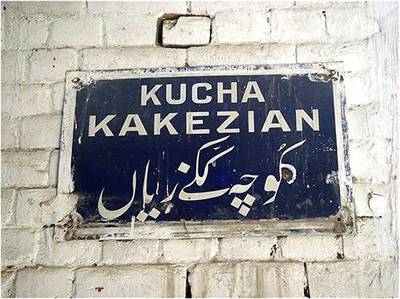
The plaque of his famous clan in the walled city
Dadabu recalls that the street next to Dabbi Bazar was called Ghaggar Galli, most of whose residents were Hindus. It was called Ghaggar Galli because the loose lower garment worn by its Hindu women was called ghaggra. There were also a few families of Kashmiri Pandits who lived there, and Dadabu’s grandfather, to whom he was far closer than he was to his own father, had the most friendly relations with them. On the occasion of the festivals of Diwali and Dusehra, the Hindu families would send their Muslim neighbours gifts of sweetmeats, a gesture that was reciprocated by the Muslims when Eid came around.
“Nehru was put on a shimmering white horse and taken in a grand procession into the old city”
In 1925, he writes, Justice Shadi Lal became the Chief Justice of the Lahore High Court. It was the same year in which Maulana Abu Muhammad Syed Deedar Ali Shah, the Khatib of Masjid Wazir Khan, declared Allama Iqbal a kafir and outside the pale of Islam. The Allama had earned the ire of the clerics because he had advised them not to interfere in the internal politics of Saudi Arabia. Maulana Suleman Nadvi declared the fatwa an edict born of ignorance. (Of course the mullahs of today are far more dangerous than the mullahs of eighty years ago, because the mullahs of today are armed with deadly weapons and command suicide bombers.) Significantly, Dadabu recalls that Lahore was plunged into turbulence when the British principal of the Mughalpura Engineering College was accused of having insulted the Prophet (PBUH). Syed Ataullah Shah Bukhari spoke all night at a protest meeting held outside Mochi Gate and when it ended in the early hours of the morning, so emotionally charged had become the crowd that it started marching towards Mughalpura to settle scores with the principal. Later it turned out that the only reason this fabricated charge had been made against the Englishman was his refusal to grant admission to a number of undeserving students.
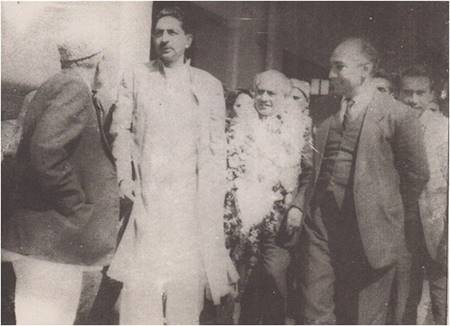
Abdulla Malik, Faiz Ahmad Faiz and Mazhar Ali khan
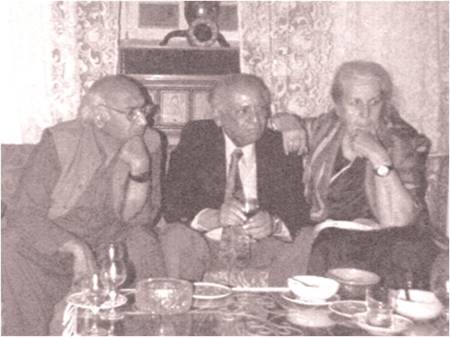
With Faiz and Alyce
Dadabu remembers a memorable visit to Lahore by Pandit Jawaharlal Nehru for the annual session of the All India Congress, which was held on the banks of the Ravi river. He writes, “When Nehru arrived at the Lahore railway station, he was received by milling crowds. Among those who were there to welcome Nehru, were men like Dr Saifuddin Kitchlew, Maulana Zafar Ali Khan, Abdul Qadir Kasuri, Chaudhri Afzal and Dr Satya Pal. Nehru was put on a shimmering white horse and taken in a grand procession along Circular Road and into the old city through Dehli Darwaza, Chowk Wazir Khan, Kashmiri Bazar, Sunehri Masjid, Dabbi Bazar, Bowli Bazar, and then into Anarkali via Rang Mahal and Machhi Hatta. Nehru was presented with a bag of money in Anarkali. According to another chronicler and lover of old Lahore, Pran Nevile, this bag of money – a thheli – was presented by the owner of the famous Bhalla Shoe Company. Justice Shadi Lal was also seen among those out to greet Nehru. The next day, when his presence was reported in the press, he issued a statement saying he had nothing to do with those who had received Nehru. The day after that, the Sikh leader Baba Kharrak Singh, was taken through the streets of Lahore on an elephant flanked by dancing Sikhs waving unsheathed kirpans. That was the way things were in those days.”
Finally, let me make a confession: This is the first time I have read the entire book in one go and it is a moveable feast. I am unable to convey the rush of energy and passion that I feel. It is as if I know all these people personally, and am connected to this land with a much stronger sense of belonging than ever before.
- See more at: http://www.thefridaytimes.com/tft/dadabu/#sthash.06UBonew.dpuf